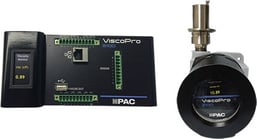
A Critical Parameter
Viscosity is one of the most critical measurement performed in a refinery, whether used for determination of product quality or to protect critical process machinery such as pumps and compressors. Historically, refined products have been defined by their viscosity. Methods and technologies have been developed over time to give operators more control over their operations. True innovations started to peak back in the 1980’s as market saturation set in for the existing analyzers which lead to a decrease in R&D and new instrumentation. Recently, the slump in oil prices has been driving improvements in the measurement and control of viscosity which in turn is leading to massive increases in profitability for refiners.
Traditional viscosity applications in a refinery
- QC Laboratory Viscometer
- On-line Viscosity Monitoring & Control
- On-line Capillary for Product Quality Measurement
The Capillary Tube- ASTM D445 Method
Off-Line viscosity measurement is the traditional approach using the ASTM-D445 method. It is recognized globally and the establish practice for the industry. It is accurate, repeatable and it works. There are however some drawback to using capillary tubes in the lab (besides, the frequent maintenance) is that while they are highly accurate, they only give you a snapshot of a very specific instant in time; the moment the sample was drawn. Take a snapshot every 8 or 12 hours and you’re going to miss something. Every moment is important and it isn’t uncommon for it to take 12 hours or more of processing time to return to on-spec once you’ve lost control and refiners can burn through $150,000 to $500,000 per occurrence. This is a completely avoidable loss.
Capillary laboratory viscometers aren’t going anywhere, anytime soon, but by pairing them with an on-line viscosity monitoring system the capillaries can fall back into the final QC role that they’re best suited for and process control is managed with real-time data.
On-line Viscosity Monitoring and Control
This approach has been around for a while and is great because it allows refiners to minimize the production of off-spec material during “product run down”, minimize the use of diluents in blending and avoid losing control of the process between lab measurements among other things. It is fantastic and the ROI can be achieved in days. The trouble here has been in finding a reliable viscometer that can meet the harsh conditions in a refinery. It is a real problem. Visit most refineries who have tried a vibrating element or torsional on-line viscometer and you’ll find a graveyard of dead instrumentation, most of it still in the line and rusting away. This is an area where a new approach was needed.
D7483 Method- The Oscillating Piston- A New Hope
The oscillating piston technique, which exhibits high correlation to primary test methods, uses a magnetically influenced piston to determine viscosity. Two electromagnetic coils drive the piston through a measurement chamber at a fixed force. The time of travel is equated dynamic viscosity and the movement of the piston refreshes the sample and keeps the measurement chamber clean. The technology is robust with no mechanical linkages to bend or break, reliable, being immune to shocks, vibrations, process disruptions and doesn’t need to be calibrated if you look at it the wrong way. The rapid data acquisition allows refiners to monitor and correct for process trends or disruptions.
The latest incarnation of the oscillating piston viscometer is the Cambridge Viscosity ViscoPro 2100 by PAC. This instrument incorporates the exceptionally rugged sensor technology with the latest forward compatible electronics to provide not only traditional outputs like Modbus and 4-20mA analog channels for viscosity, temperature and temperature compensated viscosity (TCV), but advanced features like a web UI accessible from a smartphone to allow quick and easy settings changes.
Product Quality Measurement- The ViscoSure and a New Day Dawns
If you want to reproduce the lab results and have a safe number to use for Product Quality, you need to measure Viscosity Index. There has been an approach that has been around for a long time. You set up a fast-loop bypass to a unit with two capillary viscometers immersed in two oil baths operated at different temperatures. It looks great on paper, but if you’ve ever used one, you know just how maintenance intensive these systems are. The pumps go every six months. Calibrations are frequent and everything requires draining those oil baths for access. It works when it works and when it doesn’t, you’ve got days of downtime and a big oily mess.
PAC has taken a different approach with their ViscoSure. It incorporates the proven oscillating piston technology of Cambridge Viscosity’s ViscoPro 2100 for a stable calibration and long-term dependability and couples that with an oil-less Peltier temperature control system so you get measurement at the product specification temperature. It provides 3 zone temp control to within +/- 0.1°C even with process disruptions. The instrumentation such as viscometers and flow meters are accessible within the cabinet. No draining gallons of oil just to get at your equipment. The sample conditioning system (SCS) optimizes instrument performance and protects the analyzer from process disruptions, so the analyzer is ready to go as soon as you are. The analyzer is robust enough to recover even if asphalt freezes inside and with the high correlation to primary test methods, is fast enough for blending control and accurate enough for final QC measurements.
Conclusion
Taken together, the ViscoPro 2100 and the ViscoSure are industry-driven innovations designed to address inadequacies in available instrumentation. They solve the problems that have come with the traditional approaches to on-line measurement and product quality measurements by eliminating weak-spots and enhancing the capabilities. The expandable, forward compatible platforms are designed to keep you up running through the next generation.





